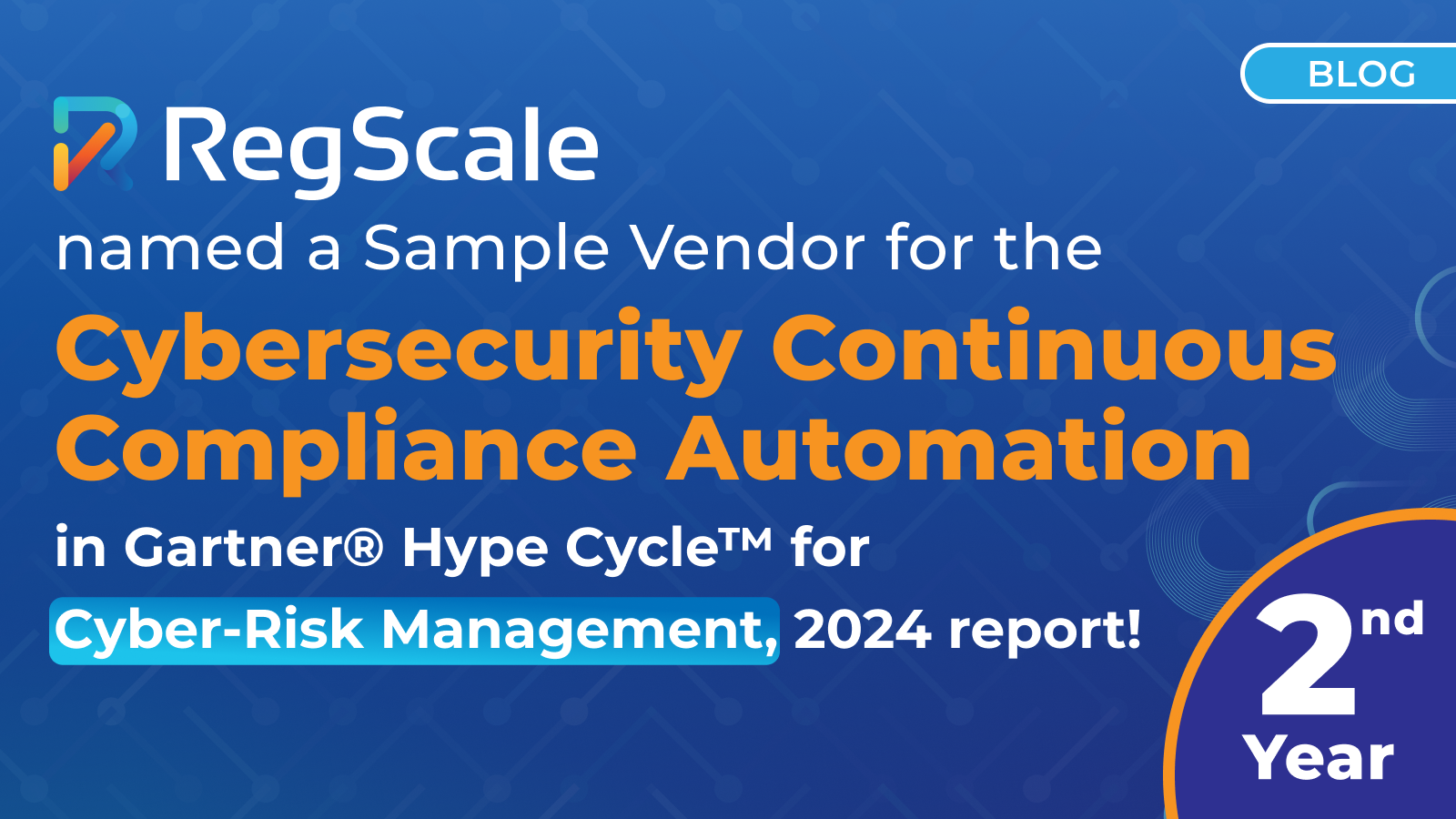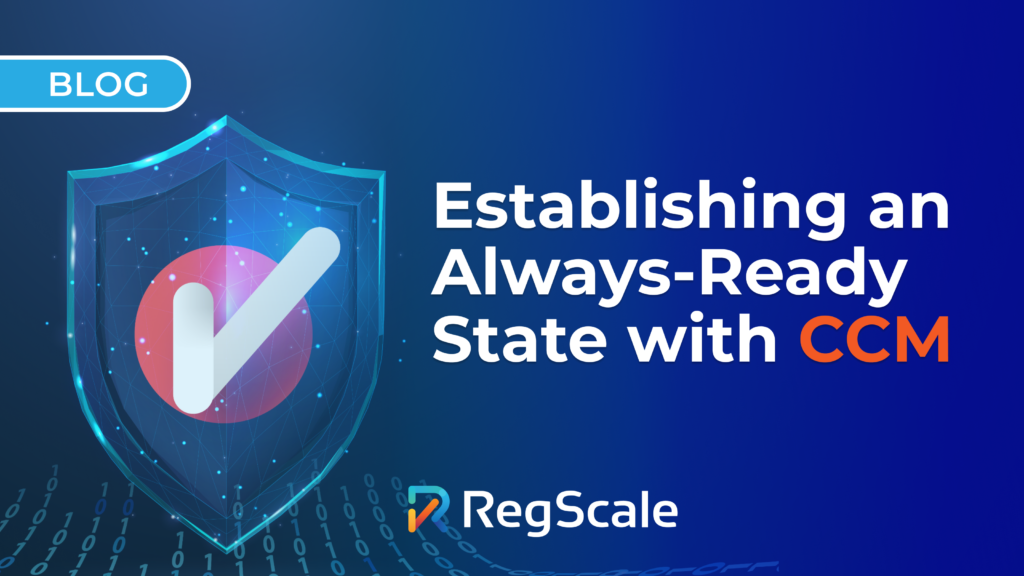RegScale Recognized as a Sample Vendor for Cybersecurity Continuous Compliance Automation category in the Gartner® Hype Cycle™ for Cyber-Risk Management, 2024 report

RegScale is recognized as a Sample Vendor for the Cybersecurity Continuous Compliance Automation category in the Gartner Hype Cycle™ for Cyber-Risk Management, 2024 report, written by Michael Kranawetter, Jie Zhang, and Pedro Pablo Perea de Duenas. As stated by Gartner in the Hype Cycle™ for Cyber-Risk Management, 2024, “Continuous compliance automation was replaced with cybersecurity continuous compliance automation.” RegScale was also mentioned in the 2023 report.
“Gartner Hype Cycle methodology gives you a view of how a technology or application will evolve over time, providing a sound source of insight to manage its deployment within the context of your specific business goals.”* Of particular interest is that Gartner identifies Cybersecurity Continuous Compliance Automation (CCCA) in the “Emerging” maturity stage, implying that the technology is on the rise and is predicted to gain wide acceptance in the next 2-5 years. Gartner states, that “tools such as Cyber GRC or Continuous Control Monitoring have overlapping capabilities with Cybersecurity Continuous Compliance Automation. Additional point solutions might prompt discussions with procurement or finance.”
According to Gartner, “cyber-risk management, now a top concern for executives and regulators, utilizes multiple methods and techniques to support governance, risk management and compliance. Security and risk management leaders can use this Hype Cycle to evaluate solutions and inform appropriate adoption decisions.”
The Gartner report states that “by 2026, 60% of cybersecurity functions will implement business-impact-focused risk assessment methods, aligning cybersecurity strategies with organizational objectives.” Furthermore, Garter’s report states that “by 2027, 40% of global organizations will extend director and officer (D&O) insurance to cybersecurity leaders, due to the increasing personal legal exposure associated with cyber-incident management.”
The Necessity of Continuous Compliance Automation
According to Gartner, “Regulatory bodies, customers and partners demand robust security posture management evidence, including certifications, attestations and accurate reporting. Security and risk management leaders must deliver continuous, precise compliance reporting. This requires enhanced monitoring, ongoing evidence collection and tailored reporting. Historically, manual, error-prone compliance activities have burdened security teams, necessitating automation and streamlined processes to reduce errors and workload.”
Transforming Business Outcomes with CCCA
As per Gartner, business impact of CCCA states,
- “Reduces the risk of noncompliance penalties
- Safeguards reputation through compliance monitoring and audit readiness, vital for stakeholder trust.
- Facilitates ongoing compliance with regulations and standards, a key factor for legal and industry standing.
- Improves compliance precision by reducing the likelihood of errors and freeing up resources/cycles for other tasks.
- Streamlines the workload of regulatory and certification requirements.”
Addressing the Challenges of Implementation
Gartner states the obstacles while adopting CCCA as follows–
- “Automation of certain tasks such as evidence collection requires integration with platforms, which depends on the availability and customization of connectors. This can pose a challenge, as not all systems may readily support necessary integrations, limiting the scope of automation.
- Certain compliance and certification requirements and their monitoring will still need to be provided and performed manually.
- Compliance support and guidance from external experts can be challenging in ensuring their recommendations are fully compatible with their organization’s existing process, culture and context.
- Auditors may occasionally use personal judgment when assessing the adequacy of evidence gathered using cybersecurity CCA tools, which could influence audit results. These rare instances can create complexities in audits due to varied interpretations of sufficient compliance.
- Tools such as CyberGRC or continuous control monitoring have overlapping capabilities. Additional point solutions might prompt discussions with procurement or finance”
User Recommendations by Gartner for Implementing Cybersecurity Continuous Compliance Automation
- “Identify compliance requirements to determine where cybersecurity CCA can help streamline and improve the compliance and auditing process.
- Before considering cybersecurity CCA, review existing security tools to identify whether any offer similar capabilities. This can optimize resources, prevent overinvestment and reduce costs.
- Evaluate the potential benefits of deploying a cybersecurity CCA tool, considering the ability of them to integrate with existing systems, and streamline and automate certain compliance tasks, such as monitoring or evidence collection.
- Evaluate the support required through cybersecurity CCA from external compliance experts, and ensure that the selected experts provide targeted guidance that aligns with the needs and context of your organization.
- Assign responsibilities for managing compliance, including reviewing and uploading evidence where not fully automated. Ensure that members understand their roles in the compliance process to maintain consistency and accountability. Configure the cybersecurity CCA tool accordingly.”
With RegScale’s continuous controls monitoring platform, Security and risk management leaders can improve operational control assurance and continuous and precise compliance and risk reporting. Organizations using RegScale integrate continuous controls monitoring and continuous compliance automation with DevSecOps to enable proactive risk management, enhanced visibility, and stronger security. CISOs become empowered to stay on top of enterprise-wide changes and maintain robust security from code to cloud.
With RegScale’s continuous controls monitoring platform, I&O and SREs shift left security by leveraging compliance as code/OSCAL (Open Security Controls Assessment Language) and automating every control lifecycle phase. The platform delivers always-on readiness and self-updating paperwork that integrates compliance as code into the CI/CD pipelines, speeds certification, reduces costs, and future-proofs security posture. The OSCAL-native platform integrates compliance as code into DevSecOps processes to demonstrate compliance requirements across the product development and delivery life cycle stages.
Only Gartner members can access the full report (For Gartner subscribers only):
Gartner, Hype Cycle for Cyber-Risk Management, 2024, Michael Kranawetter, Jie Zhang, Pedro Pablo Perea de Duenas 22 July 2024
*Gartner Methodologies, Gartner Hype Cycle
Gartner is a registered trademarks of Gartner, Inc. and/or its affiliates in the U.S. and internationally, and HYPE CYCLE is a registered trademark of Gartner, Inc. and/or its affiliates and are used herein with permission. All rights reserved. Gartner does not endorse any vendor, product or service depicted in its research publications, and does not advise technology users to select only those vendors with the highest ratings or other designation. Gartner research publications consist of the opinions of Gartner’s research organization and should not be construed as statements of fact. Gartner disclaims all warranties, expressed or implied, with respect to this research, including any warranties of merchantability or fitness for a particular purpose.
Ready to get started?
Choose the path that is right for you!
Skip the line
My organization doesn’t have GRC tools yet and I am ready to start automating my compliance with continuous monitoring pipelines now.
Supercharge
My organization already has legacy compliance software, but I want to automate many of the manual processes that feed it.
